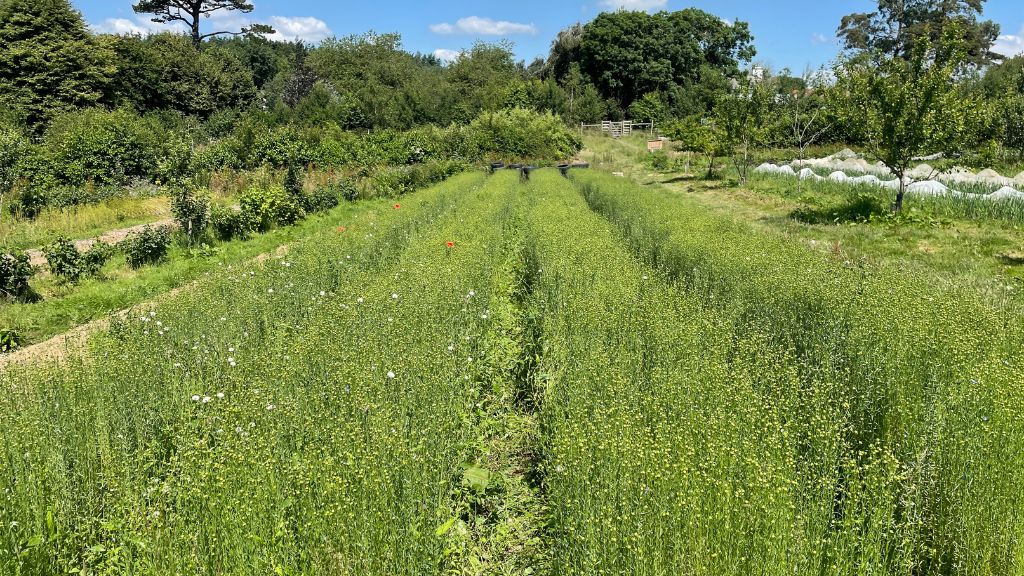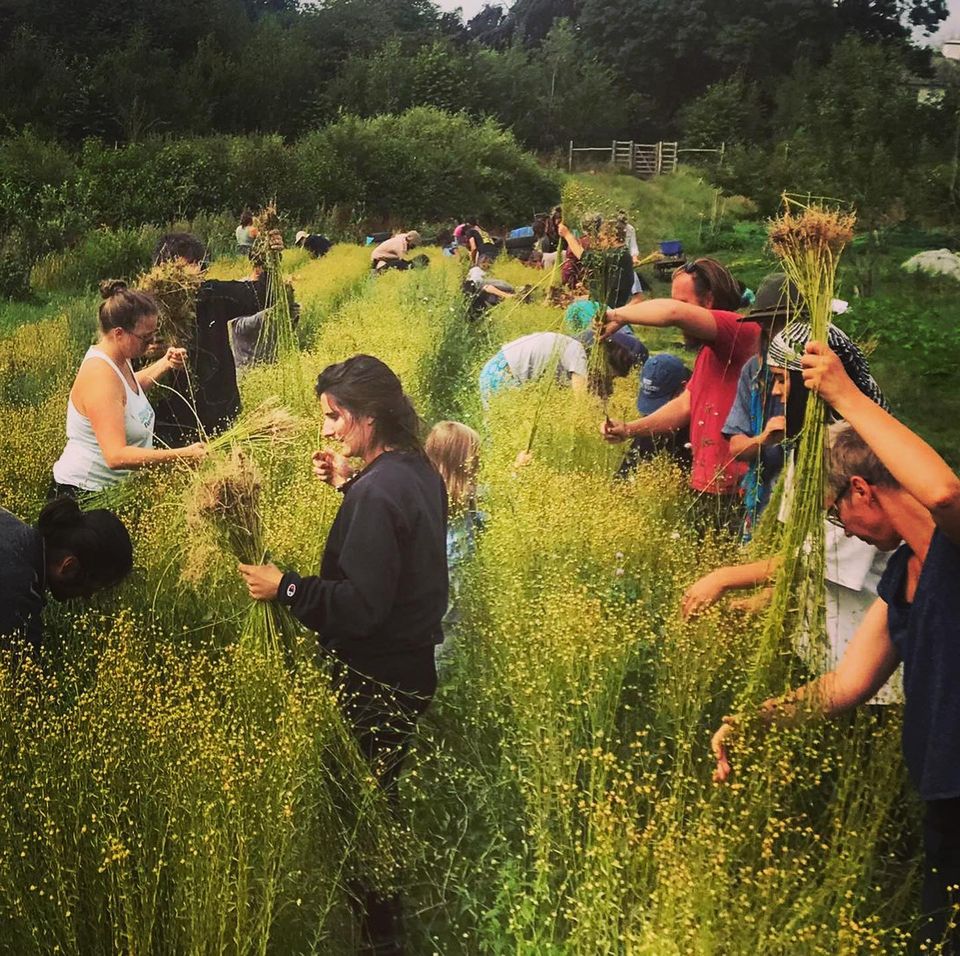Circling back to flax: Practical insights from Dartington
All teaching at Dartington takes a learning-by-doing approach, inviting students out of the lecture theatre or seminar room and into the world to experience first-hand the things they will then go on to research and put into practice in future projects. One of the best examples of this happens each year through our MA Engaged Ecology at Schumacher College, on which students are invited to experience the entire process of growing and treating flax for the purpose of making linen.

Flax beginning to flower in early summer in Henri’s Field
The idea is that when students know what it is really like to have been through the process, they are better placed to achieve a more nuanced, personal understanding of the realities and complexities of textile making. This in turn enables them to more authentically discuss our relationship with fabrics in general, whether through eco-philosophical enquiry, social-historical critique, or a more anthropological approach. Ultimately we hope this helps us to begin to come up with ideas for constructive action to help address the social and climate issues that contemporary fashion and lifestyle industries pose.
The original flax seed was donated to us by the Monreagh Heritage Centre in Ireland, who grow it as part of their education programme. For the past two years the flax has been grown in Henri’s Field, our main agroforestry-inspired growing space on the estate, and nurtured through collaboration between our gardens and horticulture staff, students on the 6-month horticulture residency and Engaged Ecology.
Flax is a relatively fast growing crop, harvestable within four months. It is quite easy to grow, and is suitable as a cover crop, preventing invasive plants taking hold, while also returning some nutrients to the soil.
Once the flax is grown successfully to maturity, there are a number of processes we explore with traditional methods, not out of any kind of nostalgia, but to really bring out a full, step by step understanding of the manual process, which mechanised versions mask or drastically speed up. To help us learn the ropes, we invited Simon and Ann from Flaxland, artisanal natural fibre growers and processors who have been specialising in flax since 2008, to spend a day with the students back in May to demonstrate the steps.
Here’s an overview of the process in pictures:
Sowing
Horticulture and Engaged Ecology students collaborate to prepare the soil and sow the seeds.

The flax grows
In Henri’s Field, the flax is grown within our alley cropping rotation system, with fruit trees and other perenniels nearby to help maintain healthy soils and encourage biodiversity.

First Flower
The beautiful pale blue flower emerges in early summer.

Pulling the flax
Traditionally flax is pulled from the ground rather than scythed or cut to retain the length of the fibres. The roots remain in the ground to contribute to the soil quality, but the fibres remain in tact.

Retting the flax
The flax is then laid on the ground for this natural process, comparable with fermentation, through which the fibres are separated from the straw by microorganisms in the soil. Rainfall and time is all that is needed to instigate this process of separation.

Drying the flax
The flax can be seen hanging from the cob barn at Schumacher College and is a nice temporary decorative feature.

Scutching and willowing
Short and long fibres are separated through a process of batting or willowing. It’s the long fibres that are particular useful for the purposes of textiles, though the other outputs of the process can also be used for other purposes so there is no waste.

Carding
To remove impurities the resulting fibre is then combed.

Spinning
Simon shows us a distaff during the spinning process.

Weaving
The thread is now ready to be woven on a loom.

Linen
A small piece of linen, woven from the flax grown here earlier this year by Isabella Goggin, one of our community learning volunteers.

Ours is a different model to that of a more traditional university, where theory and concept tend to be prioritised or even over-emphasised, and where experience is often dismissed as too subjective. Yet we have found that the painstaking effort of planting flax seeds on the land here, caring for the plants, then harvesting and processing them using traditional, hand-held tools and natural methods, and finally weaving the threads together, really brings home to students the time and energy required to produce even a small piece of fabric, and also the deep connection to the land. This experience built up over the year on the Master’s is then a springboard for students to consider ecological critiques of production practices in modern textiles and the fashion industry, for example, highlighting the destructive environmental impact of fast fashion, the economic and social inequalities it contributes to, and also the role technology plays in masking, hiding or removing labour.
At the same time, this isn’t just about critique. Insight is valuable as part of the learning process, but to really imbed change we have to start to consider solutions which respect the health of people and the planet. We also need to explore better, more project-based approaches, and potential individual or collective interventions that might improve those systems upon which we all depend.
If you are interested in joining us for MA Engaged Ecology, of which the flax is just one strand, we are open for applications from students wishing to start in January 2023. Additional part-bursaries are available for applicants who submit before 26 October. Find out more and apply via the button below.
Thanks to Emily Ashworth for providing some of these photos.
